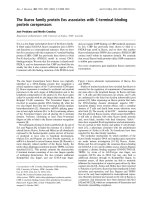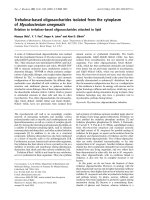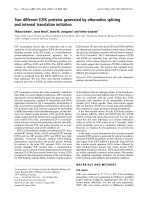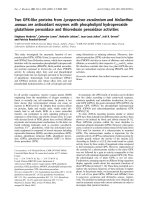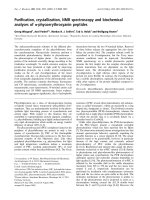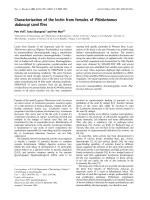Báo cáo y học: "If good things come from above, do bad things come from below" ppt
Bạn đang xem bản rút gọn của tài liệu. Xem và tải ngay bản đầy đủ của tài liệu tại đây (118.6 KB, 2 trang )
Finding the factors that initiate, or the mechanisms that
lead to progression of, osteoarthritis (OA) has proven
frustrating and largely unproductive. Identifi cation of
risk factors for the condition – such as prior trauma to
the joint, elevated body weight and female sex – may
have helped with management of OA but has done little
to progress understanding of the underlying factors that
drive it. OA research has been more diffi cult than
research for some other diseases of the skeleton, for
several important reasons. Early OA, at the level of
symptoms, can be episodic, making it diffi cult to identify
the disease and to follow it longitudinally. Since the main
early symptom is pain, clinical trials of new therapies
have been problematic. Animal experiments have been
bedevilled by a lack of models that accurately replicate
the human disease. And perhaps, as argued by a minority
of workers in the fi eld, disease initiators have been sought
in the wrong place; that is, cartilage versus bone.
e recent study of Tanamas and colleagues highlights
the way in which new-generation imaging holds the
promise of shedding new light on this old problem [1]. In
particular, high-resolution magnetic resonance imaging
(MRI) can now deliver objective, measurable information
about all structures of the joint, including the amount
and quality of articular cartilage, and is also a powerful
tool to investigate the subchondral bone. e holy grail of
clinical investigation, namely longitudinal study with
quantitative endpoints, is now accessible for OA. What
Tanamas and colleagues’ study shows is important
because it adds to emerging evidence that processes in
the subchondral bone relate strongly to changes in the
volumetric amount of articular cartilage. Specifi cally,
bone marrow lesions (BMLs), the mysterious MRI-bright
regions in the subchondral bone that occur more
commonly in OA, were shown to be predictive of loss of
cartilage and of formation of subchondral cysts. In turn,
cysts were more likely than BMLs to occur in association
with loss of cartilage.
ese data pose the intriguing question of whether
BMLs encode key clues to the aetiology of OA. Longi-
tudinal studies have shown that the presence of BMLs
constitutes a potent risk factor for structural deteriora-
tion in knee OA [2]. BML enlargement has been strongly
associated with increased cartilage loss, and Tanamas
and colleagues’ data further suggest that their conversion
into cysts is even more predictive of cartilage loss.
Signifi cantly, a reduction in the extent of BMLs on MRI
has been shown to associate with a decrease in cartilage
degradation [3]. Since the origin of BMLs is not known,
its investigation needs to be prioritised as an important
research topic. Current informed guesses are that BMLs
comprise regions of oedema, perhaps secondary to
episodes of local ischaemia. Although it is not possible to
biopsy BMLs in patients with early OA, several studies
have sought to correlate the MRI fi ndings with histology
in more severe disease. Regions of BMLs in end-stage OA
patients at knee replacement were more likely to exhibit
oedema, bone necrosis and trabecular abnormalities than
were control sites [4].
Abstract
Factors in the synovial uid that maintain healthy
articular cartilage, such as hyaluronic acid and lubricin,
come from above. Is it possible that factors which lead
to the destruction of cartilage come from below in the
subchondral bone? The recent acquisition of tools to
probe early events in osteoarthritis is shedding new
light on possible contributions from this compartment
on the initiation and progression of the disease.
Tanamas and co-workers now provide evidence that
bone marrow lesions in the subchondral bone are
predictive, both of loss of cartilage and of formation of
subchondral cysts. These data provoke questions about
the nature and role of bone marrow lesions.
© 2010 BioMed Central Ltd
If good things come from above, do bad things
come from below?
David M Findlay*
See related research by Tanamas et al., />EDITORIAL
*Correspondence: david.
Discipline of Orthopaedics and Trauma, University of Adelaide, Level 4 Bice
Building, Royal Adelaide Hospital, Adelaide 5000, South Australia, Australia
Findlay Arthritis Research & Therapy 2010, 12:119
/>© 2010 BioMed Central Ltd
If BMLs are secondary to local ischaemia in the
subchondral bone, there are several possible conse-
quences. Firstly, the supply of nutrients and oxygen from
regions of ischaemic subchondral bone, to the overlying
articular cartilage, might be reduced. Cartilage nutrition
has been considered to derive from the synovial fl uid.
e work of Imhof and colleagues, however, suggested
that more than 50% of the glucose, oxygen and water
requirements of cartilage are provided by perfusion from
the subchondral vessels [5]. ey described the dense
subchondral vasculature in close proximity to the
cartilage, and the micro-channels that penetrate the sub-
chondral mineralisation zone and permit communication
between the bone and the carti lage. More recent work
indicates that small molecules can diff use, in healthy
joints, bidirectionally from the synovial compart ment
into the cartilage and underlying bone and from the
subchondral bone into the overlying cartilage [6].
Inspection of the osteochondral junction of long bones
reveals that osteocytes and osteocyte canaliculi, which
are also probable conduits of nutrients, are inti mately
associated with the articular cartilage. Experi mental
inter ruption of contact between articular carti lage and
subchondral bone results in degeneration of the cartilage,
and osteoblasts from OA subchondral bone conferred
catabolic changes in articular chondrocytes [7].
Secondly, osteocyte death in bone is becoming
recognised as a signalling event for osteoclastic removal
of the nonviable bone and its replacement in a remodel-
ling episode [8]. Although subchondral bone is constantly
being remodelled, concentration of this activity in a
particular region of the bone could alter its mechanical
integrity and its ability to properly support the overlying
cartilage.
Tanamas and colleagues conclude that cysts (and
BMLs) may provide therapeutic targets for the treatment
of knee OA [1]. Certainly, the recent acquisition of tools
to probe early events in subchondral bone in OA should
deliver rapid advances in our understanding of the
natural history of this condition.
Abbreviations
BML, bone marrow lesion; MRI, magnetic resonance imaging; OA,
osteoarthritis.
Competing interests
The author declares that he has no competing interests.
Published: 27 May 2010
References
1. Tanamas SK, Wluka AE, Pelletier JP, Martel-Pelletier J, Abram F, Wang Y,
Cicuttini FM: The association between subchondral bone cysts and tibial
cartilage volume and risk of joint replacement in people with knee
osteoarthritis: a longitudinal study. Arthritis Res Ther 2010, 12:R58.
2. Felson DT, McLaughlin S, Goggins J, LaValley MP, Gale ME, Totterman S, Li W,
Hill C, Gale D: Bone marrow edema and its relation to progression of knee
osteoarthritis. Ann Intern Med 2003, 139:330-336.
3. Garnero P, Peterfy C, Zaim S, Schoenharting M: Bone marrow abnormalities
on magnetic resonance imaging are associated with type II collagen
degradation in knee osteoarthritis: a three-month longitudinal study.
Arthritis Rheum 2005, 52:2822-2829.
4. Zanetti M, Bruder E, Romero J, Hodler J: Bone marrow edema pattern in
osteoarthritic knees: correlation between MR imaging and histologic
ndings. Radiology 2000, 215:835-840.
5. Imhof H, Sulzbacher I, Grampp S, Czerny C, Youssefzadeh S, Kainberger F:
Subchondral bone and cartilage disease: a rediscovered functional unit.
Invest Radiol 2000, 35:581-588.
6. Pan J, Zhou X, Li W, Novotny JE, Doty SB, Wang L: In situ measurement of
transport between subchondral bone and articular cartilage. J Orthop Res
2009, 27:1347-1352.
7. Sanchez C, Deberg MA, Piccardi N, Msika P, Reginster JY, Henrotin YE:
Subchondral bone osteoblasts induce phenotypic changes in human
osteoarthritic chondrocytes. Osteoarthritis Cartilage 2005, 13:988-997.
8. Noble B: Bone microdamage and cell apoptosis. Eur Cell Mater 2003,
6:46-55.
doi:10.1186/ar3007
Cite this article as: Findlay DM: If good things come from above, do bad
things come from below? Arthritis Research & Therapy 2010, 12:119.
Findlay Arthritis Research & Therapy 2010, 12:119
/>Page 2 of 2

